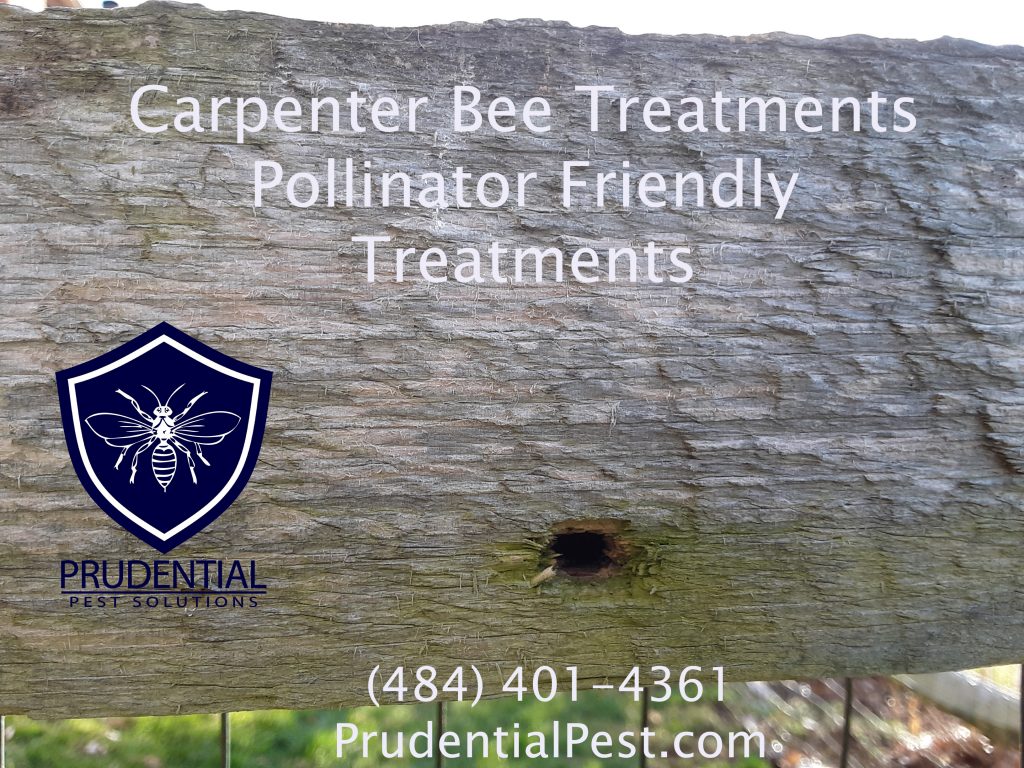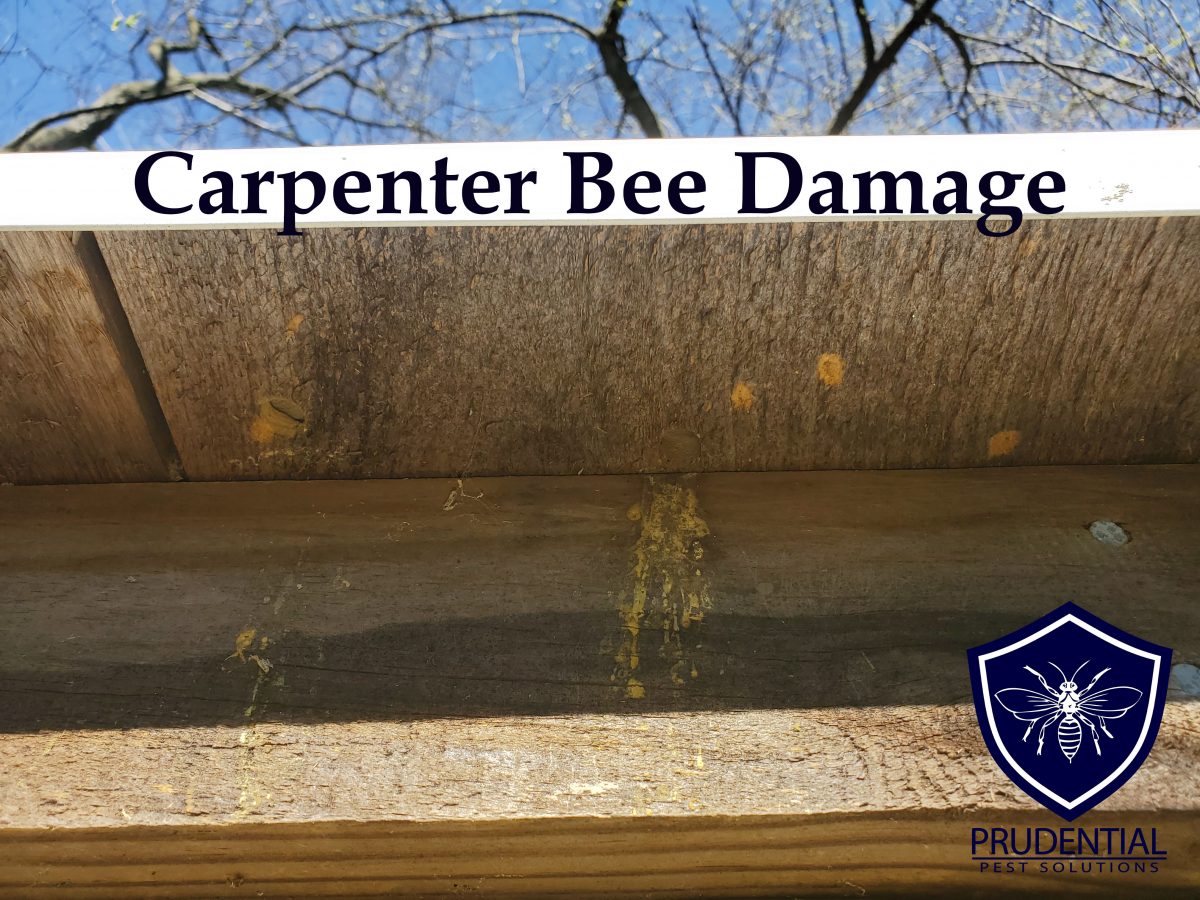I found an interesting article in the 1962 edition of Annals of the Entomological Society of America on the Life of a Carpenter Bee. Although written almost 60 years ago, the author provides some great insight into the daily and yearly habits of the carpenter bee
The carpenter bees used in the study are Xylocpa Virginica. This species is found in Chester County and throughout all of Pennsylvania and all of the Eastern coast of the U.S.
Carpenter Bee Identification
Carpenter bees are large bees that resemble bumble bees. You will most likely encounter them hovering around wooden structures where they have created nests.
Carpenter Bee Life Cycle
Carpenter bees are mostly active during the warm summer months. We start to receive calls about carpenter bee treatments in May and continue through August.
Carpenter Bee Mating and Breeding
In the study, Balduf describes the mating and breeding habits of the carpenter bee. The carpenter bees emerge from their nests when the weather warms up in mid to late spring. Once they emerge, they will begin to search for nectar and a mate.
From mid spring through mid summer, it is very common to see carpenter bees “swirling” together in the air. This is part of their mating habit. It is very common to see more than 2 bees together in their circling mating habit. I have seen multiple bees together crash into the ground, separate, and then fly off together.
There is strong evidence that the actual mating takes place inside of the nest itself. This is supported by the observation of male bees that will hover near the openings of female nests.
Carpenter Bee Eggs and Larva
Female carpenter bees can lay up to 6 eggs total. The female will deposit the egg onto a “bread” that they create out of pollen and nectar. The egg and food are then sealed into a chamber of the nest.
The sealed eggs are placed in sequence with the oldest and first laid egg in the very back. This first laid egg will develop first and must chew its way past the other eggs and larva.
Carpenter Bees throughout the year
New bees will develop and emerge from the nest around August/September every year. The new bees will forage for some resources and then hibernate for the winter.
The adult carpenter bees that you have been swatting at all summer will typically not survive to winter. This means that next generation of carpenter bees usually has no contact with the previous generation.
Carpenter Bees Hibernate
During the winter months, the carpenter bees were seen in a hibernation pattern. This involves the bees hibernating front to back in a single chamber of the nest. The formation will face away from the main nest opening.
When the weather begins to warm in the spring, the carpenter bees will emerge and begin the process again
Carpenter Bee Nests
Now that we’ve described the life cycle of the carpenter bee, let’s look at where and how they live.
The above diagram was documented in Baldruf’s study. It shows a cross section view of 3 different nests. In the study, Baldruf describes how many live carpenter bees were found in each nest.
Each of these nests, when cut open, was discovered to have between 6-10 adult carpenter bees. The nests ranged in length from 10-14 inches.
The bottom nest, #3, is shown to have brood cells. In section C of nest #3, we can see the segments of the brood cells. The segments are the different sealed egg chambers described above. We can see that there are 5 separate chambers with the first laid one being to the far right.
Carpenter Bee Nest Locations

Carpenter Bee nests are fairly easy to spot. They prefer unpainted and untreated wood. Carpenter bees will drill a 1/2″ sized entrance hole perpendicular to the wood grain. Once they have drilled in approximately 1/2″, they will drill with the grain of the wood to create their galleries seen in the diagram above.
Carpenter bees nests will have piles of sawdust under them from their drilling process. The nest may also have what looks like yellow/brown splash marks on the opposite wall. This is from their excrement from drilling into the wood and then expelling it as they exit the nest.
Carpenter Bee Nest Damage
When we thing about wood damaging and destroying insects, we think of termites, wood beetles, and carpenter ants. Carpenter Bees are also in this category of wood destroyers. Although their damage is more cosmetic than structural, carpenter bees can still cause tremendous damage.
Carpenter Bees are Pollinators
In addition to being wood destroying insects, carpenter bees are also pollinators. They use the nectar to provide nourishment for themselves and their brood.
Unlike honey bees and bumble bees, there are FAR less carpenter bees around. This means that carpenter bees are not important pollinators.
Carpenter Bee Treatments
Since carpenter bees create their nests in wood, that is where the treatment should be located. The application of an insecticide dust into each nest opening is a very effective treatment for carpenter bees.
If you would like to learn more about carpenter bee treatments, check out our page on carpenter bees here
Carpenter Bee Recap
Carpenter bees large, nuisance bees that can be safely and effectively treated. For most situations, simply having all of the wood painted will be enough to deter most carpenter bees.
Since one female carpenter bee can create up to six carpenter bees come fall, it is important to not delay treatment. Over the course of a few years, your seemingly small carpenter bee problem can escalate rather quickly.
Carpenter Bee Treatments Chester County
We provide carpenter bee treatments in Chester County PA. If you live or work in Chester County and would like to schedule a carpenter bee treatment, give us a call or send us a message!

Additional Information
Citations
W. V. Balduf; Life of the Carpenter Bee, Xylocopa virginica (Linn.) (Xylocopidae, Hymenoptera), Annals of the Entomological Society of America, Volume 55, Issue 3, 1 May 1962, Pages 263–271, https://doi.org/10.1093/aesa/55.3.263

Comments are closed